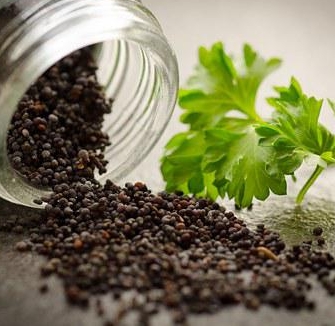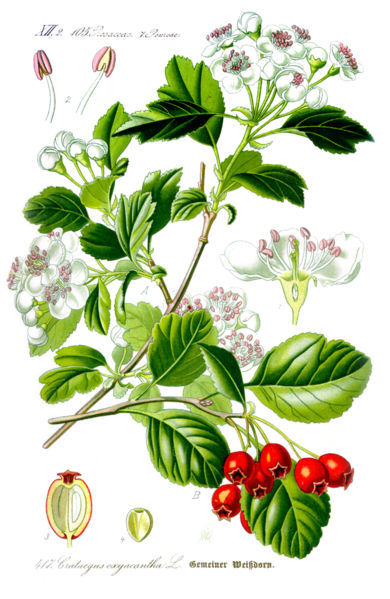Give Your Heart Some Love—with Hawthorn
Hawthorn isn’t just a herb; it’s a heart-centered embrace. Beyond its sweetly appealing taste and physical benefits, this gentle yet powerful plant carries an emotional sanctuary for the heart—spiritually and botanically. Clinically supported for its cardiovascular benefits, hawthorn offers nourishment, rhythm, and resilience to both heart and soul.
Hawthorn is a small flowering shrub in the Rose family, and like most rose family plants, it is edible and quite tasty at that. Similar to other rose family plants, hawthorn has a special affinity for the heart, both spiritually and physically.
Hawthorn has well-documented clinical studies showing its effectiveness in both treating and preventing cardiovascular disease, particularly congestive heart failure, damaged myocardium, and coronary artery disease.
It is also a gentle herb, so it is well tolerated by most people who take it with very few risks for side effects or overdosing…so eat your heart out!!
The leaf, flower, and berries are all used medicinally, so if you are harvesting the flowers, be sure to leave enough behind so you can get some berries in the fall.
The berries are often made into concentrated extracts, which can be eaten by the spoonful…which is a delicious way to get your heart-healthy herbs in. They can also be made into a tea or a tincture.
Energetically, hawthorn is helpful for healing a broken heart. A giving and loving plant, hawthorn shrubs are also covered in large thorns; you must approach with caution and respect, similar to the way you would want someone to approach you in situations concerning the heart and love.
Hawthorn is also a wonderful boundary-promoting herb for people who tend to love too freely and often end up getting hurt; hawthorn will help you create the needed boundaries that keep you protected but also allow you to give your love to the right people.
So whether your heart troubles are physical or emotional, or if you just want to give your heart some love and protection of its own, hawthorn can be a wonderful ally.
Traditional & Clinical Insights
- Physical Heart Support
Deep-rooted in both traditional herbalism and modern research, hawthorn leaf, flower, and berry offer a nurturing tonic for the cardiovascular system. Clinical trials have demonstrated its effectiveness in improving symptoms and quality of life for individuals with chronic congestive heart failure (CHF). Notably, standardized extracts such as WS 1442 and LI 132 helped increase exercise tolerance and reduce fatigue and shortness of breath when used alongside conventional treatments [1]. - Mechanisms of Action
Hawthorn’s benefits stem from its rich composition—flavonoids and oligomeric proanthocyanidins help relax blood vessels, reduce oxidative stress, lower blood lipids, and support endothelial function and anti-inflammatory balance [2–4]. - Safety & Interactions
While generally well-tolerated, hawthorn may enhance the effects of heart medications and hypotensive action, especially in sensitive individuals [5–8]. It’s especially important to consult a practitioner if already on medications like digoxin or beta-blockers.
Botanical & Energetic Character
Hawthorn is a thorny shrub in the Rose family—Rosaceae. Its name, Crataegus, stems from the Greek for “strength,” a testament to its cardiovascular fortitude [9]. In spring, it blooms in light clusters of white or pink flowers; in autumn, these give way to berry-like haws, rich in gentle food-medicine goodness.
Energetically, hawthorn tenderly heals the heart. Its thorns signify boundaries; its blossoms and berries offer comfort, protection, and loving resilience—especially for those recovering from emotional wounds [10–12].
MATERIA MEDICA
Latin Name: Crataegus spp.
Family: Rose (Rosaceae)
Parts Used: Leaf, flower, berry
Energetics: Slightly moist, neutral temperature, sweet
Primary Actions: Cardioprotective, cardiotonic, antiarrhythmic, antioxidant, trophorestorative (restoring the heart’s structure and rhythm)
Traditional & Modern Uses:
- Congestive Heart Failure (CHF)
- Coronary Artery Disease / Angina
- Damaged Myocardium / Heart Attack Recovery
- Hypertension / Orthostatic Hypotension
- Anxiety, Depression, Emotional Healing (“Broken Heart”)
- Family history of cardiovascular disease
Preparations & Dosage
- Tea/Infusion: 1 tbsp hawthorn leaf, flower, or berry in 8–10 oz hot water; steep 15–25 minutes. Drink three or more cups daily for heart support.
- Tincture: 90 drops, 3 times per day.
- Standardized Extracts: 200–300 mg, 2–3 times daily (e.g., WS 1442, LI 132) [1, 13].
Cautions & Considerations
- Medication Interactions: Hawthorn may amplify effects of heart medications, especially antihypertensives and digitalis derivatives [5, 6]. Always consult a qualified practitioner before combining them.
- Hypotension Risk: Those prone to low blood pressure (particularly the elderly) should use carefully and monitor closely.
- Mild Side Effects: Overdoses may cause dizziness or nausea; very high doses could affect rhythm in rare cases [7, 8].
- Not a Substitute: While heart-affirming and supportive, hawthorn should not replace prescribed treatment plans.
Final Reflections
Hawthorn is a profound ally, offering a physical embrace to the heart and a gentle sacred space for emotional repair. Its thorns remind us of the protective boundaries we need; its bloom invites love and healing in. As a cardiovascular tonic, it strengthens; as a spiritual ally, it uplifts.
References
- AAFP. (2010). Hawthorn in Heart Disease. American Family Physician. Retrieved from https://www.aafp.org/pubs/afp/issues/2010/0215/p465.html
- NCBI. (n.d.). Roles and Mechanisms of Hawthorn. Retrieved from https://pmc.ncbi.nlm.nih.gov/articles/PMC7047282
- Restorative Medicine. (n.d.). Hawthorn Monograph. Retrieved from https://restorativemedicine.org/library/monographs/hawthorn
- NCBI. (n.d.). Hawthorn in Cardiovascular Disease Treatment. Retrieved from https://pmc.ncbi.nlm.nih.gov/articles/PMC3249900
- Verywell Health. (2009). Hawthorn: Benefits and Nutrition. Retrieved from https://www.verywellhealth.com/the-benefits-of-hawthorn-89057
- Health.com. (2013). Herbs You Should Avoid Mixing With Heart Meds. Retrieved from https://www.health.com/condition/cholesterol/heart-trouble-15-herbal-remedies-to-avoid
- Wikipedia. (2025). Crataegus. Retrieved from https://en.wikipedia.org/wiki/Crataegus
- NCBI. (n.d.). Hawthorn in Cardiovascular Disease Treatment. Retrieved from https://pmc.ncbi.nlm.nih.gov/articles/PMC3249900
- Pacific Rim College. (2017). Plant Feature: Hawthorn. Retrieved from https://www.pacificrimcollege.com/2017/11/plant-feature-hawthorn-crataegus-spp
- Hawthorn & Honey. (n.d.). Connecting to Beltane: The Medicine of Hawthorn Flowers. Retrieved from https://www.hawthornandhoney.com/journal/connecting-to-beltane-the-medicine-of-hawthorn-flowers
- Pacific Rim College. (2017). Plant Feature: Hawthorn. Retrieved from https://www.pacificrimcollege.com/2017/11/plant-feature-hawthorn-crataegus-spp
- Rowan + Sage. (n.d.). Celandine Flower Essence. Retrieved from https://rowanandsage.com/shop/p/celandine-flower-essence-cwdgb
- Herbrally. (n.d.). Hawthorn Monograph. Retrieved from https://www.herbrally.com/monographs/hawthorn
This information is for educational purposes only This information has not been evaluated by the Food and Drug Administration and is not intended to diagnose, treat, cure, or prevent any disease.
Browse by category
- Aphrodisiacs
- Aromatherapy
- Astrology & Magic
- Ayurdeva
- Botany Foraging & Gardening
- Chakras
- Digestion
- Earth Connection
- Energetics
- Flower & Gem Essences
- Folk Traditions
- Herbalism & Holistic Health
- Immune Support
- Materia Medica
- Mushrooms
- Nutrition
- Seasonal Living: Autumn
- Seasonal Living: Moon Cycle
- Seasonal Living: Spring
- Seasonal Living: Summer
- Seasonal Living: Winter
- Skin & Body Care

Don’t Miss a Thing!
Enter your email below to be the first to know about sales, new products and tips for taking care of your pieces.


